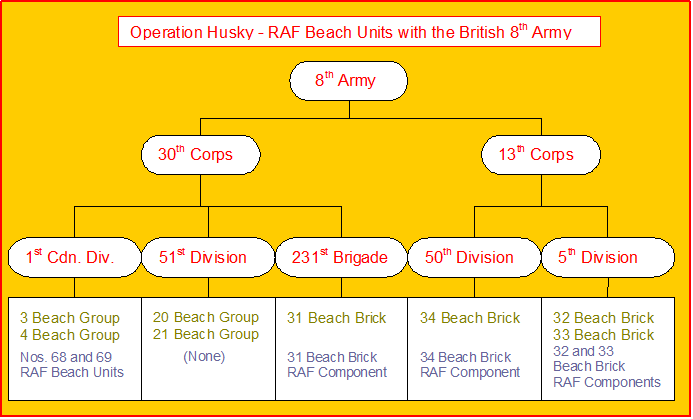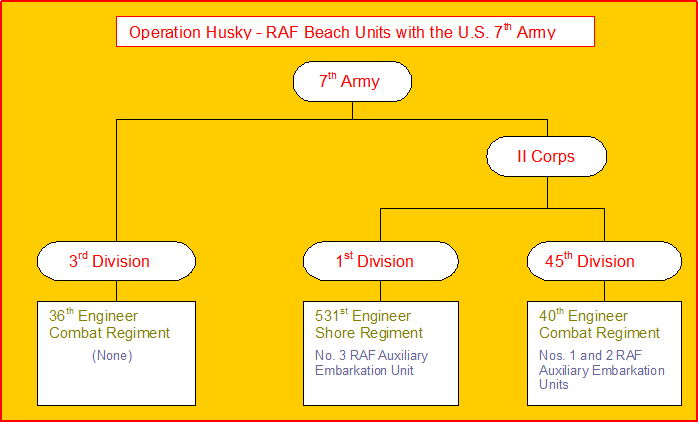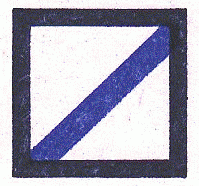Operation “HUSKY” – The Invasion of Sicily
D-Day, 10th July 1943
The invasion of Sicily was the first move back into Europe by the Allies and the first big seaborne assault on a coast held by the enemy. The assault landing was actually larger in scale than the more famous landings in Normandy nearly a year later. The British seaborne assault force alone consisted of four infantry divisions and an independent brigade group.

These assault forces, and the beach units that were to land with them, came from different regions.
The Ist Canadian Infantry Division sailed direct from the U.K. bringing its own beach units. These were No. 3 Beach Group with No. 68 R.A.F. Beach Unit attached and No. 4 Beach Group with No. 69 R.A.F. Beach Unit attached.
The 231st Infantry Brigade, together with the 50th Infantry Division and the 5th Infantry Division came from Suez, Alexandria and Haifa at the eastern end of the Mediterranean. The beach organisations that supported these forces were Nos. 31, 32, 33 and 34 Beach Bricks, each of which had an R.A.F. Component.
The 51st Infantry Division came from Tunisia, some of it via Malta and the beach organisation they brought consisted of Nos. 20 and 21 Beach Groups. No R.A.F. beach units were attached.
The co-ordinating administrative headquarters for the beach organisation of 30 Corps was 103 Lines of Communication Sub Area and the senior R.A.F. officer at that H.Q. was Wing Commander Hackett. The equivalent H.Q. for 13th Corps was to begin with, 86 Lines of Communication Area and later, 151 Lines of Communication Area.
86 L. of C. Area, commanded by Brigadier H. C. N. Trollope, has been described as becoming “almost the 8th Army’s administrative ‘assault-force’ in the days of the advance to Tripoli in January 1943.” [1]
Whilst no R.A.F. beach units accompanied 51st Division, R.A.F. beach units from North Africa were, however, attached to some of the American assault forces.

The 3rd U.S. Infantry Division embarked at Bizerta and landed at Licarta. The 36th Engineer Combat Regiment were responsible for the beach work. No R.A.F. beach units were attached.
The 1st U.S. Infantry Division embarked at Algiers and Oran for the Gela landings. The R.A.F.’s No. 3 Auxiliary Embarkation Unit were attached to the 531st Engineer Shore Regiment.
The 45th U.S. Infantry Division sailed from the U.S.A., stopped briefly at Oran and was joined by its L.S.T.s and smaller craft off Bizerta. The 45th Division landed at Scoglitti and the 40th Engineer Combat Regiment had the R.A.F.’s No. 1 and No. 2 Auxiliary Embarkation Units attached.
RAF Beach Units involved in Operation Husky
| From the U. K. | From North Africa | From the Middle East |
|---|---|---|
| 68 Beach Unit | 1 Aux. Emb. Unit | 31 Beach Brick Component |
| 69 Beach Unit | 2 Aux. Emb. Unit | 32 Beach Brick Component |
| 3 Aux. Emb. Unit | 33 Beach Brick Component | |
| 34 Beach Brick Component |
The various R.A.F. beach units involved in HUSKY were of roughly the same size and had the same essential purpose. However, there were differences in composition and organisation between beach units formed in the three separate regions. For example the United Kingdom Beach Units each included an M.T. repair section of 18 men and the Middle East Beach Brick Components instead had a larger number of men for explosives duties who were intended to transfer later to the air ammunition parks when they were established.
All the beach units landed early on D-Day and on schedule, in spite of a heavy sea swell. Although progress differed on the various beaches, the work of the beach groups on all the beaches was made easier due to “anchorages mostly calm, no tides, dry beaches and roads, and little interference from the enemy” [2]. Although there were some difficulties and quite a few lessons still to be learned, maintenance over the beaches proved to be more easy in Sicily than generally thought possible and although not necessary because the ports were soon brought into use, could have continued over a long period of time.
The R.A.F. beach units were generally successful in carrying out their allotted tasks but they were hampered by a lack of equipment. It became apparent that they should be more self-sufficient and in particular, needed to have mechanical transport, i.e. some trucks and jeeps of their own.
[1] Molony, C. J. C. “The Mediterranean and Middle East Vol. 5, The Campaign in Sicily 1943 and the Campaign in Italy 3rd September 1943 to 31st March 1944”, 1973, p143
[2] ibid, p140
